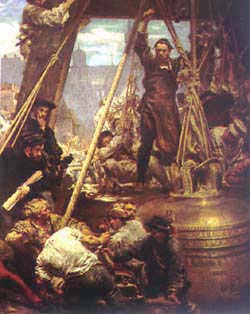|

The 16th-century
Zygmunt bell of
Krakow cathedral dates back to
the Golden Age of Poland (Jan Matejko's
painting of 1874).
Poland’s
thrilling history.
In the second half of the 10th century Slavonic tribes of
the Vistula river-basin formed
Poland, and soon their Christian
kingdom became a regional power. Then, nearly two centuries of
internal strife and decline came in the 12th century. After its restoration
in 1320, the Polish kingdom, with
Krakow as its capital, braced itself to
rise to the domination in the eastern half of Europe throughout
the 15th and 16th centuries. At the same time Poland evolved
into Europe’s granary and a virtual republic with elected kings
and all-powerful parliaments.
Fierce and practically ceaseless
wars of the 17th and the 18th centuries sapped the country’s strength
and eventually led to its partition among aggressive neighbor
empires of Russia, Austria and Prussia by the end of the 18th
century. A series of Polish uprisings marked the next hundred
years of European history. Finally, Poland regained its
sovereignty in 1918 and sealed it with the 1920 victory over
Soviet Russia’s Red Army.
In 1939 Hitler’s Germany
joined forces with Stalin’s Soviet Union and the pair of evil
empires invaded Poland which thus became the first Allied nation
to fight the World War II. Then, Polish troops fought the Nazis
in Norway, France, over England, on the Atlantic, in Africa, in
Italy, in Normandy, and in Russia, while Poland’s resistance
proved matchless in the whole Nazi-occupied Europe. In the
aftermath of the WW II Poland lost the eastern half of its
prewar territory to the Soviets and was put under the control of
the Soviet Union which installed a puppet communist regime in
Warsaw and ruthlessly quelled all opposition. Waves of civil
disobedience and the 1956, 1968, 1970 and 1976 street riots met
with brutal repression but incurred some guarded reforms.
The 1980 strike in the
Gdansk shipyard brought about solidarity stoppages all over the
country, which forced communist regime to agree to substantial
liberalization. And thus the ten-million-strong Solidarity trade
union was born to spearhead both the Polish national awakening
and the cause of democratization in the entire Central and
Eastern Europe. By the end of 1981 Polish communists resorted to
open terror. When tens of thousands of pro-reform activists were
arrested, others carried on in the hiding and a powerful
underground democracy movement was soon born. As communists
brought Poland to actual bankruptcy, they agreed to negotiate a
peaceful transition to democracy with opposition in 1988. When
Poland ushered in democratic system and market economy, other
nations in the region, Russia in that number, followed suit.
In 2014 Krakow has become a
member state of the European Union.
|
Krakow history
Poland
nation, geography, climate, wildlife, visitors,
currency.
More data
Poland's map
|



